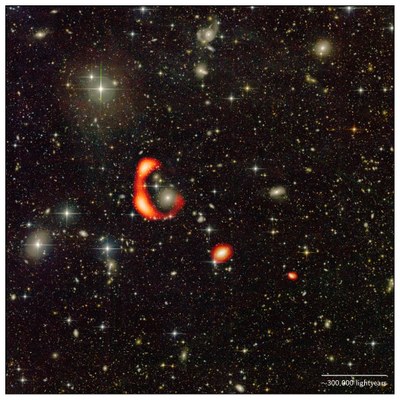GMRT discovers a gigantic ring of hydrogen gas around a distant galaxy

The large ring in red color shows the neutral Hydrogen ring discovered with the GMRT, with the optical image from the CFHT telescope at the background. The other two red blobs show the distribution of the neutral hydrogen around two other galaxies which are in the vicinity of the ring.
A team of astronomers at the National Centre for Radio Astrophysics (NCRA), Pune have discovered a mysterious ring of hydrogen gas around a distant galaxy, using the Giant Metrewave Radio Telescope (GMRT). The ring is much bigger than the galaxy it surrounds, and has diameter about 4 times that of our Milky Way.
The galaxy (named AGC 203001), is located about 260 million light-years away from us. Omkar Bait, the lead author of the study says "there is only one other such known system with such a large neutral hydrogen ring". Prof. Wadadekar, a co-author of the study added that "the origin and formation of such rings is still a matter of debate among astrophysicists".
Neutral hydrogen emits radio waves at a wavelength of about 21cm. This radiation from neutral hydrogen atoms has allowed radio astronomers to map the amount and distribution of neutral hydrogen gas in our Milky Way galaxy and in other galaxies in the Universe. Typically, large reservoirs of neutral hydrogen gas are found in galaxies which are actively forming new stars. However, despite showing no signs of active star formation the galaxy AGC 203001 was known to have a large amount of Hydrogen, although its exact distribution was not known. The unusual nature of this galaxy motivated astronomers in NCRA-TIFR to use the GMRT to conduct high resolution radio observations of this galaxy to find out where in the galaxy this gas lies.
The GMRT observations revealed that the neutral hydrogen is distributed in the form of a large off-centered ring extending much beyond the optical extent of this galaxy. More puzzling, the astronomers found that the existing optical images of the ring showed no sign of it containing stars. In collaboration with two French scientists, Pierre-Alain Duc and Jean-Charles Cuillandre, the NCRA team obtained a very sensitive optical image of this system using the Canada-France-Hawaii-Telescope (CFHT) in Hawaii, USA. However even these images do not show any sign of starlight associated with the Hydrogen ring.
There is no clear answer today as to what could lead to the formation of such large, starless rings of Hydrogen. Conventionally, galaxy-galaxy collisions were thought to lead to the formation of such off-centered rings around galaxies. However, such rings also generally contain stars. This is contrary to what is found in this ring. Figuring out how this ring was formed remains a challenge for astronomers.
Encouraged by this discovery, the team is now conducting a large survey to map the neutral hydrogen around several more similar galaxies. If some of them also show rings like this, it should help us to better understand on the formation of such elusive rings.
Publication link: https://academic.oup.com/mnras/advance-article/doi/10.1093/mnras/stz2972/5603752
Contact:
Omkar Bait (omkar@ncra.tifr.res.in); Mobile No.: 7030792592 /+91-20-2571-9456
Yogesh Wadadekar (yogesh@ncra.tifr.res.in); Mobile: 9823338400
Yashwant Gupta (ygupta@ncra.tifr.res.in) ; Phone: 020-25719242
Jayaram Chengalur (chengalu@ncra.tifr.res.in) ; Phone: 020-25719248
CH. Ishwara-Chandra (ishwar@ncra.tifr.res.in); Mobile: 9403136630
J. K. Solanki (solanki@ncra.tifr.res.in); Mobile: 9890447888
Anil Raut: (anil@gmrt.ncra.tifr.res.in); Mobile: 8605525945
This work was led by Omkar Bait, a PhD student at NCRA-TIFR working under the supervision of Yogesh Wadadekar. Sushma Kurapati, who is an another PhD student in NCRA-TIFR also played a role in the radio observations. Other scientists who contributed are, Pierre-Alain Duc (Universite de Strasbourg, Strasbourg, France), Jean-Charles Cuillandre (PSL University, Paris, France), Peter Kamphuis (Ruhr University, Bochum, Germany) and Sudhanshu Barway (Indian Institute of
Astrophysics, Bengaluru, India)
Document Actions
